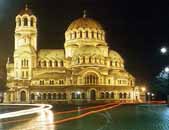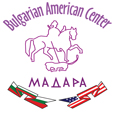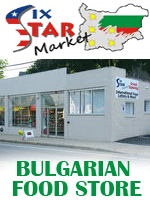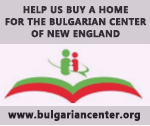 |
|
 |

 |
 |
|
|
Sofia, the Belle of the Balkans
Point of View: 11 June 2005, Saturday.
By Barry Zwick
Los Angeles Times
Just another Saturday night in this capital so long disparaged as a
Balkan backwater. Just another wine bar with a 24-page wine list. Just
another grand opera. Just another glamorous piano bar.
Before my eyes, scaffolding was coming down all over the city, like a
box of bonbons being unwrapped.
I arrived in Sofia one Friday night in October with a plan to spend
most of two weeks visiting Bulgaria's historic villages, riding the
rails and rooming in mom-and-pop inns. I was in Bulgaria because I had
heard it was cheap, pretty and fun. I started in Sofia only because
that's where the airport is.
After 24 hours here, I scrapped my plan. No trains, no historic
villages. Just Sofia.
What captivated me was a lovely, vibrant, stylish city, filled with
flowers, fountains, statues, monumental architecture, broad
boulevards, richly landscaped parks, good restaurants, friendly people
- all for a bargain.
Prices were a third of what they were at home in Los Angeles, a fourth
of what they were in most of Europe. A cup of coffee costs about 20
cents in Sofia, a fine three-course meal with a couple of glasses of
good wine, $9 to $12.
"I thought of Sofia as a run-down Vienna when I first arrived here
three years ago," international accounting consultant Bernard J.
Thompson told me one day at breakfast at the Sheraton Hotel Sofia
Balkan. "But that was before the reconstruction commenced."
Sofia and, to a lesser degree, the rest of Bulgaria, awoke from a
slumber of many centuries only four years ago, when voters tossed out
most of the remaining Communists in the National Assembly.
Parliamentarians chose as their new prime minister Simeon
Saxe-Coburg-Gotha, the former boy king who had lived in exile in Spain
since 1946.
The new prime minister brought in a brain trust of young Bulgarian
expatriate bankers from London and New York and turned the tax code
upside down. International investment poured in. Bulgaria joined NATO
in 2004 and is hoping to be admitted to the European Union in 2007.
"Things are going well," Thompson said. "They have some distance to go
in terms of rooting out corruption, but they speak our language."
At the peak of Sofia's colossal makeover in August, the city's
unemployment rate had dropped to 3.26%, and international tourism had
increased by 50%. After the city's massive face-lift, the
once-cratered sidewalks and the pitted streets are smooth, the dome on
the Bulgarian Academy of Sciences golden again.
Exploring on foot
You won't need a car or a taxi if you visit, and you can save the
colorful trolleys for rainy days. Sofia was the most walkable city I
have found in more than 30 years of foreign travel.
The walker's Sofia is shaped like a gull with wings outstretched, with
the Balkan Sheraton and the neoByzantine St. Nedelya Church forming
St. Nedelya Square as its head. The lobby of the Sheraton, the grande
dame among Sofia's six ultra-luxurious hotels, is a tourist attraction
in itself, filled with antique chalices, ornamental clocks and
expansive oils. A boulevard that changes official names from block to
block but is called the Yellow Brick Road - paved in 1917 with yellow
bricks from Vienna - is the gull's right wing.
Fashionable Vitosha Boulevard, where you'll find shops bearing names
such as Versace, Ermenegildo Zegna, Chanel and Donna Karan, is the
left wing.
On my first morning in Sofia, I followed the Yellow Brick Road. Nearly
all of Sofia's landmarks are on or near this boulevard, which is
seven-tenths of a mile. The first three blocks, called the Largo, are
lined with bright green lawns and the flags of NATO nations.
At my left was TSUM, once a grim department store modeled after
Moscow's GUM. Today, it's a gleaming glass-and-marble four-story
complex of elegant shops - Swarovski, Nautica, Calvin Klein, Limoges,
Victorinox.
I walked down the Yellow Brick Road until it became an aisle through a
valley of Hapsburg wedding cakes, white and yellow neo-Baroque
buildings including the Presidency, the National Art Gallery, the
National Ethnographic Museum and, ahead on my left, the onion-domed
emerald-and-gold St. Nicholas Russian Church.
When I peeked in, the church was filled with smoke from pots of
burning incense and packed with worshipers, mostly young people.
I soon came to an enormous black equestrian statue of Russian Czar
Alexander II, who freed Bulgaria from the Turks in 1878. Alexander
faces the National Assembly on his right and the stunning
Russo-Byzantine St. Alexander Nevsky Cathedral, the symbol of Sofia,
on his left. At his backside is the Radisson Grand and Flannagan's
Irish Pub, a hangout for parliamentarians as well as tourists.
No walker should miss the Theater District, just south of St. Nedelya
Square, a pedestrian haven surrounding the red, white and gold
neo-classical National Theater Ivan Vazov, set amid a pool and
fountains and filled with sidewalk cafes. Whenever I was lost at
night, which was often, I could count on a customer at the outdoor
Café Theater to point me to my destination.
Crossing the Yellow Brick Road is Rakovsky Street - party central,
with nightclubs, restaurants, bars and the National Opera.
Early one afternoon, I headed to Rakovsky Street in search of wine and
a light lunch.
I found both at Vinobar, which was to become my hangout. I checked out
the 24-page wine list, gave up and turned to the bartender, Milana
Harlacheva, for help. She recommended the No Man's Land merlot, a
full-bodied wine from Melnik, heart of one of Bulgaria's five wine
regions. "No Man's Land" was the name for the barren three-mile-wide
strip between Bulgaria and Greece to which refugees from Communism
once fled, risking death at the hands of Soviet soldiers. Today, No
Man's Land is filled with grapevines.
Another history lesson came with dinner, at chic Checkpoint Charly's
in the shadow of the National Theater. Place mats were copies of Cold
War-era front pages from the Bulgarian Communist Party newspaper,
Rabotnichesko Delo, or Workers' Daily. Mine led with student
demonstrations in Warsaw against U.S. actions during the Vietnam War.
The room was painted half black, half white, with a sign in the middle
saying - in English, Russian and German - "You are entering the
American sector."
As a jazz trio played "Hallelujah, I Love Her So," I feasted on katak
- red pepper stuffed with feta, yogurt and walnuts - and chicken
seasoned with parsley, dill and cilantro and baked in yogurt. I had a
bottle of fine Cabernet Sauvignon from a vineyard near the Black Sea
and, for dessert, a huge caramel sundae. My bill: $21... |
|
|
|






